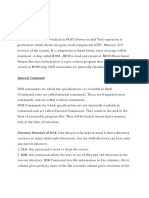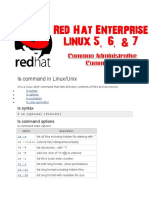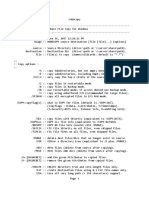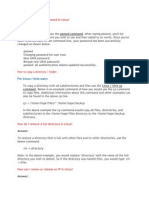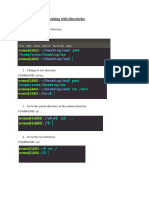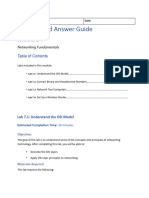Batch File Programming
Uploaded by
Deol PeterBatch File Programming
Uploaded by
Deol PeterBATCH FILE PROGRAMMING ::
*********************************
TWO MODES : INTERACTIVE MODE AND BATCH/SILENT MODE
IN INTERACIVE MODE : AS THE COMMAND IS TYPED IN THE PROMT ASKS FOR THE USER TO I
NTERACT IN THE BATCH MODE AFTER THE COMMAND IS TYPED IN THE USER IS NOT REQUIRED
EG :: DEL COMMAND
del a ;used for deleting the contents of a folder->once this command is typed in
it asks for a confirmation
del /q a ; here no confirmation is asked the '/q' switch runs the command in the
batch mode
when saving : save the file as a .bat extension from a notepad
two types of commands :: internal and external commands : internal -> commmands
which are default to all systems
and external -> commmands which are system specific
Batch Operators : Usual operators
Operator precedence : (),/,*,%,+,-
Sub commands and switches
eg : net users a a /add : here 'net' is the main command,'users' is the sub-comm
and,/add is the switch : basically the command adds a new user 'a' with a passwo
rd 'a'to the total users of the computer
COMMAND LIST
*****************
del :: commmad to delete the contents of a folder
/q : switch to run in batch mode
echo :: print the following command
pause :: to wait for the user's intervention at the end of the program
set :: for operations
/a : to do arithmetic operations such as addition etc - set /a 5+5 gives
10 as output
> :: Redirection of output
eg : echo hello > a.txt ; outputs hello to the text file a.txt ; NB : if a.
txt is not available, it creates it
~ :: Shortening of the path names : eg : documents folder can be represent
ed by docume~1 : NB : Apply '~' after 6 characters
&& :: Multiple command operation in a single line
| :: To give the output of one command as the input to another
eg : echo y | del *.txt ; gives a 'y' as confirmation whenever the del comm
and is called upon
help :: to get help
/? :: to get help on a specific command eg : net /? : gives help on a speci
fic command
REM :: For remarks
color :: for setting the color of the cmd display : eg :: color 1 2 :: first n
umber is the background color and the second one represents the foreground color
title :: To change the title of the cmd window
propmt :: Changes prompt
cls :: Clear Screen
date :: To change the current date
: /t : displays the current date
time :: To change the current time
: /t : displays the current time
start :: to start a new program with options
: /d : Starting directory of the shell
: /min : To start in the minimised mode
: /max : To start in the maximimsed mode
: /separate & /shared : To assign seperate or shared memory
: /low;/mormal;/high;/abovenormal;/belownormal;/realtime :: Setting prio
rity
: /wait : waits till the program terminates
: /b : opens up new command prompt without a new window,when you type ex
it it exits out of the new prompt
exit : To exit from command prompt
call :: Used to call another batch program
tasklist:: Lists out the entire tasks and processes
/s : To specify the remote machine to connect with
/u : Username
/p : Password
eg : tasklist /s sys1 /u admin /p admin
/m : Display the corresponding .dll files
/svc:displays corresponding services
/v : To display the verbose information
/fi: To filter the results
Filter parameters : eq,ne,gt,lt,ge,le
FILTER NAMES VALID VALUES
*****************************
STATUS RUNNING or NOT RESPONDING
IMAGENAME IMAGE NAME
PID PID VALUE
SESSION SESSION NUMBER
SESSIONNAME SESSION NAME
CPUTIME CPU TIME : HH:MM:SS
MEMUSAGE MEMORY USAGE IN KB
USERNAME USERNAME
SERVICES SERVICE NAMES
WINDOWTITLE WINDOW TITLE
MODULES DLL NAME
EG : TASKLIST /FI "STATUS EQ NOT RESPONDING"
taskkill :: To kill a task
eg : taskkill /s 192.168.1.1 /u a /p a /im a.exe : to kill process a.exe in the
system 192.168.1.1 with username a and password a
/im : To end imagename
/f : To forcefully terminate
/pid: To end the process with the given id : eg: taskkill /f /pid 001
/t : to end all the corresponding threads and child processes
/fi : Same as in the tasklist
label :: To change the label of a drive eg : label D: Softwares -> Replaces D:
drive name with Softwares
tree :: Lists every details and files in a directory in tree format
/f : For an elaborate tree
/a : For displaying in ascii characters instead of extended characters
ver :: Displays the version of the os
type :: Displays the contents of a file
convert :: To convert filesystems
eg : convert c: /fs:NTFS -> /fs : The filesystem to convert to is specified by
/fs switch
shutdown::Variants of shuttingdown the system
-s : Shutting down
-r : Reboot System
-l : Log off
-a : Abort shutdown
-t : To specify time for shutting down : Time should be entered in seconds
-c : To specify comments for shutting down : eg : shutdown -s -c "Shutting Do
wn"
-i : To open remote shutdown dialog box
/m : To remote shutdown a system whose address is known
eg : shutdown /m 101.101.1.1 -r
/f : To forcefully terminate a program and shutdown
at :: To schedule an operation
eg : at 101.101.1.1 8AM "notepad.exe"
/delete ; Switch to delete an already scheduled task
eg : at 556 /delete :: To delete a task with job ID 556
at /delete /yes : To delete all tasks without confirmation
/interactive : to make the scheduled tasks more user interactive
/every : to schedule on a routine schedule
eg : at 5:00PM /every:M,T,TH,S,SU a.exe : Here we have entered days
/next : to schedule for next items : eg: at /next:1,10,20 a.exe : Here we ha
ve entered dates
CONDITIONAL STATEMENTS
*****************************
IF: if errorlevel 1 ( echo failed ) else ( echo success )
dir : Lists the directories and the files in a folder
/a : Attribute switch - parameters -> r : readonly files,h : hidden,d :
directories,s : system files,a : files ready for archiving,i : not content index
ed files : eg : dir /as - to display all the system files
/b : To display the bare information alone
/c : To display the file sizes with seperator;/-c : To display the file
sizes without seperator
/d : To display the file extensions alone
/l : To display the results in lower case
/o : To display the output in the required format : s:size;n:name;e:exte
nsion;d:date/time;g:group directories first
/p : If output overflows an existing page the user is prompted to press
a key
/q : Displays the owner of the files
/s : Displays detailed information
/t : To create logs : c:Creation date;a:Accessed date;w:Write date eg: d
ir /tc
/w : For a wide list
/x : To display in small names : in 8dot3
/4 : To display dates in 4 digits
mkdir : make directory : MKDIR A\B\C ; MKDIR "MY COLLECTIONS" -> IF SPACE IN
THE NAME USE DOUBLE QUOTES
RMDIR : REMOVE DIRECTORY : /S : USED TO DELETE ALL SUB-DIRECTORIES;/Q : USED T
O DELETE IN QUIET MODE -> NO PROMPTING THE USER
CHDIR : CHANGE DIRECTORY
NB : TO GET TO THE DRIVE WINDOW AFTER CHANGING TO A VARIED DIRECTORY IN THE DRIV
E SAY IN DRIVE F:;TYPE IN CMD : F:\
REN : RENAME EG: REN A B->RENAMES A DIRECTORY WITH NAME 'A' AS 'B'
replace : similar to copy commmand eg:replace c:\a\a.txt c:\b /a -> Copies a.txt
from folder a to folder b.Here the /a switch is used to specify that
a new copy is to made.Without this /a switch in most cases nothing occurs.
/p : Asks for user confirmation. /r : Copy read only files. /s : Used to
copy files in all the sub-directories. /u : Used to append to a
n existing file or update./w : wait for the user to enter a disk etc.
copy : NB:You cannot copy directories as such : if at all directories are men
tioned only its contents are copied to the destination folder eg :
copy c:\a.txt d: -> Copies a.txt to d:
/a : Copy files in ascii mode;/b : save files in binary mode;/d : destti
nation folder is decrypted;/v : verifies if files are written properly;/n :
create short file names;/y : prevent confirmation if a file already exists;/-y :
asks for the neede confirmation;/z : to copy networked files
xcopy : Better than copy as it has got much more options.
/d : Used to copy files which are modified after a particular date : eg
: xcopy /d:m-d-y c: f: ->here m-d-y is substituted with the required da
te.
/exclude : Used to restrict copying certain type of files : xcopy /exclu
de:.txt c: f:
/p : To propmt the user to create a new folder if copying to a non-exis
tant folder
/s : Copies all the sub-folders etc which are not empty
/e : Copies even the empty folders
/v : To verify if copying was done properly
/w : To ask for prompting to copy
/c : To continue copying even if an error occurs
/q : To prevent the display of the names of the items being copied
/f : To display the full source and destination names of the items being
copied
/l : To display the names of the files that are supposed to be copied
/g : To copy encrypted files into folders that does not support the encr
yption
/h : copying files that are hidden and has system attribute
/r : Copying files that has read only attribute.
/t : Creates a directory structure
/u : To copy files already in the destination directory
/k : To copy the attributes also in usual case the attributes are resett
ed in the case of the new copied file
/n : Copies the file ownership and access control attributes so that the
security remains the same
/x : In addition to the /n settings it also copies the audit settings
/b : To create a shortcut
/y : To ask for confirmation ;/-y : To not ask for confirmation
/z : To copy networked files
pushd : Keeps the current working directory or the required directory in the s
tack until it pops out
popd : Gets to the earlier directory
eg : rem "Current working directory is c:"
pushd d:
rem " Goes to directory d:"
popd
rem " Takes you back to directory c:"
NB : dir a -> lists the files in the 'a' folder
NB : del a -> does not delete the empty folders in the 'a' folder
move : The classic 'cut' operation
eg : move c:\a c:\b -> Moves the folder'a' to folder 'b' in the c: direc
tory.
net : Network troubleshooting commands
user : To create,delete and password setting of a user account
/add : To add new user
eg : net user a a /add -> adds a new user with name 'a' and pass
word 'a'
To change the password for the user 'owner' : type "net user owner *"
It will ask for the new password and you will have to confirm it.
/delete : to delete a user :: net user owner /delete :: To delete the us
er owner
/times : to specify the time allowed for the user to logon : Times she
n he could logon eg : net user a /times:all
here the 'all' parameter sees to it that the user 'a' can log
on at all times by default if /times is not given any value then
it will not be able to logon at any time
To view all user related information just type "net user owner" -> to get info
on the user 'owner'
localgroup : It can be used to give a user administrator privileges you
can put a user into any of the user groups
eg: net localgroup administrator owner /add -> to add owner user
into administrator group
You can view the different groups available by just typing "net localgro
up"
/comment :To give comment to the particular user you have created
eg:net localgroup owner /add /comment:"Owner"
net localgroup a /delete : To delete the user 'a' from a localgroup
net view : To view the hostnames of all the computers in the same networ
k
net view /all : To view all hostnames even if offline
net view /cache : To view all the cached files
net time : To get the time fromv a time server
net start : To start a service; eg: net start spooler
ping : Packet Inter Net Gopher :eg : ping 192.1.1.1 : To send icmp signals to th
e specified system : By default windows sends 4 signals - if for each there is a
reply then it means a good connectivity.
-t : Unlimited number of signals are send : It could result in the speci
fied system crashing.
-a : Resolves the IP addresses into corresponding host names
-n : Used to specify the number of packets to be send : eg : ping -n 2 1
92.1.1.1 -> sends 2 packets to the specified machine
-l : To specify the size of the packets : maximum size is 65500 bytes
-f : No fragmenting of the packets
-I : To set the time to leave (ttl)
-v : Used to set the type of service(tos)
-s : Set timestamp for each hops
-j : To ping to list of hostnames in a file: eg:ping -j hostfile.txt 101
.1.1.1
-k : Forces packets to flow to the specified host
-w : To set waiting time for the echo reply
telnet : to connect to a remote host : eg:telnet a - > connects to a system wit
h hostname 'a'
-a:Auto logon to the remote host
-f:Logs all the successful logons and the unsuccessful logons etc
-l:Logons with the local user credentials
-t:Helps to specify the termonal type : like : ansi,vtnt,vt100,vt52
Telnet is usually done into the port 23 but you can also telnet to the p
ort 21 which is the port for ftp by
telnet 101.1.1.1 21
tracert : Trace Route eg : tracert www.google.com
-d : No resolving of ip address
-h : To change the number of hops : maximum : 30 ->by default eg : trace
rt -h 5 www.google.com
-j : To tracert to a list of hostnames in a file eg : tracert -j a.txt
-w : To set delay times in milliseconds
ipconfig : Used to display the details about the mac address,the network connect
ions etc.
/all : Used to display the detailed info of the above stated and more pa
rameters
/release : Used to release the currently assigned ip address
/flushdns : Used to clear the dns resolver cache
/registerdns : Used to re-register the dns
/displaydns : Used to display the dns cache
/showclassid : Displays all the Class IDs that are usable for the curren
t adapter
/setclassid : Used to set the class IDs for the specific adapter
* : Used to set wildcards : eg : ipconfig /release abc* -> releases the
ip with 'abc' as the starting
hostname : Dispalys the name of the host
ftp : To download and upload files ; eg : ftp a.com -> connecting to the rem
ote server of a.com
eg : ftp a@a.com -> where username is 'a'
ftp -a -> implies anonymous login if allowed
dir : displays all the ftp directories
in ftp ; nothing is encrypted even the username and password is tranfere
d as plain text so its better use encrypted versions such as ssh.
pwd : Present Working Directory : Displays the current working directory
get : eg ; get a,txt -> gets the file from the ftp server
send : eg : send a.txt -> uploads the file into the remote server
mget and mput : to get and send multiple files form and into the remote
server respectively
bye : To get out of the ftp prompt
ascii : To set the mode of transfer into ascii mode
binary : To set the mode of transfer into binary mode
delete : To delete a file from the remote server
rmdir : To remove a particular directory from the remote system
-n : Autologin
-i : Deactivate the interactive mode
-s : It takes up a text file and runs the ftp commands in it
You might also like
- Top 30 Linux System Admin Interview Questions & AnswersNo ratings yetTop 30 Linux System Admin Interview Questions & Answers16 pages
- Lab Experiment No.02: Introduction To Computing (COMP-01102) Telecom 1 Semester100% (1)Lab Experiment No.02: Introduction To Computing (COMP-01102) Telecom 1 Semester5 pages
- Windows Command Line Cheat Sheet PDF Hackr - Io100% (1)Windows Command Line Cheat Sheet PDF Hackr - Io27 pages
- Idoc - Pub - All Commands in Ms Dos PDFNo ratings yetIdoc - Pub - All Commands in Ms Dos PDF44 pages
- Common SSH Commands or Linux Shell CommandsNo ratings yetCommon SSH Commands or Linux Shell Commands3 pages
- How To Get Familiar With Ubuntu Commands: StepsNo ratings yetHow To Get Familiar With Ubuntu Commands: Steps9 pages
- CyberAces Module1-Windows 3 CommandLineBasicsNo ratings yetCyberAces Module1-Windows 3 CommandLineBasics23 pages
- DIR - List Files and Folders - Command PromptNo ratings yetDIR - List Files and Folders - Command Prompt2 pages
- 50 Most Frequently Used UNIX - Linux Commands (With Examples)No ratings yet50 Most Frequently Used UNIX - Linux Commands (With Examples)12 pages
- Configuration of a Simple Samba File Server, Quota and Schedule BackupFrom EverandConfiguration of a Simple Samba File Server, Quota and Schedule BackupNo ratings yet
- Firewall Config-Cisco-Inst CCTV Camera-IT NetworkNo ratings yetFirewall Config-Cisco-Inst CCTV Camera-IT Network4 pages
- Instant Download Fedora Linux Servers With Systemd 3rd Edition Richard Leland Petersen PDF All Chapter100% (2)Instant Download Fedora Linux Servers With Systemd 3rd Edition Richard Leland Petersen PDF All Chapter62 pages
- Managing Volumes and File Systems For VNX ManuallyNo ratings yetManaging Volumes and File Systems For VNX Manually100 pages
- Internet: Presented by Shahnaz Begum ROLL NO. 2020/B.ED/0092No ratings yetInternet: Presented by Shahnaz Begum ROLL NO. 2020/B.ED/009211 pages
- Cisco IOS Configuration Fundamentals Command ReferenceNo ratings yetCisco IOS Configuration Fundamentals Command Reference1,549 pages
- Linux Iptables Firewall Configuration: Prince - KenshiNo ratings yetLinux Iptables Firewall Configuration: Prince - Kenshi8 pages
- FTP Client API On z/OS®: Communications Server z/OS V1R5 and V1R6 Technical UpdateNo ratings yetFTP Client API On z/OS®: Communications Server z/OS V1R5 and V1R6 Technical Update29 pages
- MA5800 V100R018C00SPH109 Patch Installation Guide 01 (From V100R018C00HP1102)No ratings yetMA5800 V100R018C00SPH109 Patch Installation Guide 01 (From V100R018C00HP1102)29 pages
- DGS 1005D - Manual - V - 4 - 3 - 0 - EN - UK PDFNo ratings yetDGS 1005D - Manual - V - 4 - 3 - 0 - EN - UK PDF20 pages
- How To Generate Sophos UTM Logs of Different Module For Sohpos IViewNo ratings yetHow To Generate Sophos UTM Logs of Different Module For Sohpos IView76 pages
- Top 30 Linux System Admin Interview Questions & AnswersTop 30 Linux System Admin Interview Questions & Answers
- Lab Experiment No.02: Introduction To Computing (COMP-01102) Telecom 1 SemesterLab Experiment No.02: Introduction To Computing (COMP-01102) Telecom 1 Semester
- 50 Most Frequently Used UNIX - Linux Commands (With Examples)50 Most Frequently Used UNIX - Linux Commands (With Examples)
- Configuration of a Simple Samba File Server, Quota and Schedule BackupFrom EverandConfiguration of a Simple Samba File Server, Quota and Schedule Backup
- Instant Download Fedora Linux Servers With Systemd 3rd Edition Richard Leland Petersen PDF All ChapterInstant Download Fedora Linux Servers With Systemd 3rd Edition Richard Leland Petersen PDF All Chapter
- Managing Volumes and File Systems For VNX ManuallyManaging Volumes and File Systems For VNX Manually
- Internet: Presented by Shahnaz Begum ROLL NO. 2020/B.ED/0092Internet: Presented by Shahnaz Begum ROLL NO. 2020/B.ED/0092
- Cisco IOS Configuration Fundamentals Command ReferenceCisco IOS Configuration Fundamentals Command Reference
- Linux Iptables Firewall Configuration: Prince - KenshiLinux Iptables Firewall Configuration: Prince - Kenshi
- FTP Client API On z/OS®: Communications Server z/OS V1R5 and V1R6 Technical UpdateFTP Client API On z/OS®: Communications Server z/OS V1R5 and V1R6 Technical Update
- MA5800 V100R018C00SPH109 Patch Installation Guide 01 (From V100R018C00HP1102)MA5800 V100R018C00SPH109 Patch Installation Guide 01 (From V100R018C00HP1102)
- How To Generate Sophos UTM Logs of Different Module For Sohpos IViewHow To Generate Sophos UTM Logs of Different Module For Sohpos IView





























